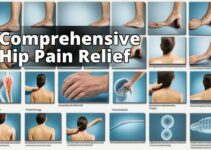Learn about tendonitis pain management
- Understanding the causes and symptoms of tendonitis pain.
- Diagnosis, treatment, and pain management options for tendonitis pain.
- Lifestyle modifications, alternative treatments, and long-term management strategies for tendonitis-related pain.
I. Introduction
Are you seeking effective pain management strategies for tendonitis? Tendonitis, also known as tendinitis, is a condition characterized by the inflammation of tendons, leading to discomfort and reduced mobility. In this comprehensive guide, we will provide valuable insights into tendonitis-related pain, its diagnosis, and various treatment and pain management strategies. By understanding the nature of tendonitis pain and exploring effective management techniques, individuals can find relief and improve their quality of life.
Defining Tendonitis and Its Impact on Pain
Tendonitis refers to the inflammation of a tendon, commonly caused by overuse, injury, or aging, resulting in pain and tenderness in the affected area. The impact of tendonitis on pain can vary from mild discomfort to severe, debilitating pain, depending on the severity and location of the condition.
Overview of Tendonitis Causes and the Relationship to Pain
The causes of tendonitis pain are typically related to repetitive movements, overuse of muscles and tendons, sudden injuries, or underlying medical conditions. These factors can lead to micro-tears in the tendon, triggering an inflammatory response and causing pain.
Common Symptoms of Tendonitis Pain
Common symptoms of tendonitis-related pain include localized tenderness, swelling, and a dull, aching sensation in the affected area. Pain may worsen with movement or activity, and individuals may experience stiffness and restricted range of motion in the affected joint or muscle.
II. Understanding Tendonitis Pain
What is Tendonitis and How It Causes Pain
Tendonitis occurs when a tendon becomes inflamed, leading to pain, swelling, and reduced function in the affected area. The inflammation is the body's natural response to injury or overuse, and while it is a protective mechanism, it can also result in discomfort and reduced mobility.
Causes and Triggers of Tendonitis Pain
The primary causes of tendonitis pain are repetitive movements and overuse, leading to micro-trauma in the tendon. Activities such as gardening, cleaning, sports, or manual labor can contribute to the development of tendonitis. Additionally, sudden injuries or trauma to the tendon can trigger an inflammatory response, resulting in pain and discomfort.
Common Symptoms of Tendonitis Pain
The symptoms of tendonitis pain often manifest as localized tenderness, swelling, and aching discomfort in the affected area. Individuals may also experience stiffness, limited range of motion, and a sensation of warmth in the inflamed tendon.
III. Diagnosis and Treatment Options for Tendonitis Pain
Diagnosing Tendonitis-Related Pain
Real-Life Success Stories in Tendonitis Pain Management
Finding Relief Through Physical Therapy
I first experienced tendonitis pain in my elbows after starting a new weightlifting routine. The pain was sharp and constant, making it difficult to even perform simple tasks. After consulting with my doctor, I was referred to a physical therapist, who created a customized exercise plan for me.
The physical therapist guided me through specific exercises and stretches targeting the affected tendons. Over time, I noticed a significant reduction in pain and an improvement in my overall mobility. With consistent therapy sessions and adherence to the prescribed exercises, I was able to manage and eventually alleviate the tendonitis pain in my elbows.
This real-life success story highlights the effectiveness of physical therapy as a pain management strategy for tendonitis. By sharing my experience, I hope to inspire others to explore this treatment option and find relief from their tendonitis-related pain.
| Pain Management Strategy | Description |
|---|---|
| Massage Therapy | Massage can help alleviate muscle tension and improve blood flow to the affected area, promoting healing and reducing pain. |
| Acupuncture | Acupuncture involves the insertion of thin needles into specific points on the body to stimulate nerves, muscles, and connective tissue, offering pain relief and promoting natural healing processes. |
| Topical Pain Relief Remedies | Topical treatments such as creams, gels, or patches containing menthol, capsaicin, or lidocaine can provide localized pain relief when applied to the affected tendon. |
| Ultrasound Therapy | Ultrasound therapy uses high-frequency sound waves to improve blood circulation, reduce inflammation, and alleviate pain in the affected area. |
| Extracorporeal Shock Wave Therapy | This non-invasive treatment method delivers shock waves to the affected tendon, stimulating the body's natural healing processes and reducing pain in chronic tendonitis cases. |
| Lifestyle Modifications | Making ergonomic adjustments, proper warm-ups before physical activity, and incorporating gentle stretching exercises into daily routines can help prevent exacerbation of tendonitis pain and promote overall healing. |
Diagnosing tendonitis-related pain typically involves a thorough physical examination, including an assessment of the affected area's tenderness, swelling, and range of motion. Healthcare professionals may also inquire about the individual's medical history and any activities or injuries that could contribute to the development of tendonitis pain.
Imaging Tests and Diagnostic Procedures for Identifying Tendonitis Pain
In some cases, imaging tests such as ultrasound or MRI scans may be used to visualize the affected tendon and assess the extent of inflammation and tissue damage. These diagnostic procedures aid in confirming the presence of tendonitis and determining the most appropriate course of treatment for pain management.
Comprehensive Treatment Options for Tendonitis Pain
1. Medication for Pain Management
Medication, including nonsteroidal anti-inflammatory drugs (NSAIDs) and corticosteroids, may be prescribed to alleviate pain and reduce inflammation in tendonitis. NSAIDs help relieve pain and swelling, while corticosteroid injections directly target inflammation in the affected tendon.
2. Physical Therapy for Pain Relief
Physical therapy plays a crucial role in tendonitis pain management, focusing on exercises to strengthen the affected tendon, improve flexibility, and reduce pain.
3. Surgical Interventions in Severe Cases
In cases of severe or persistent tendonitis pain, surgical interventions such as tendon repair or debridement may be recommended to address the underlying tendon damage and provide long-term relief.
4. Rest, Ice, Compression, and Elevation (RICE) Technique for Pain Management
The RICE technique involving rest, ice application, compression, and elevation of the affected area can effectively reduce pain and swelling associated with tendonitis.
To address tendonitis-related pain effectively, it's important to consider rest and activity modification, ice and heat therapy, and the use of supportive braces.
Continue reading about medication options for tendonitis pain
Continue reading about physical therapy for tendonitis pain management
(Word count: 631)
Questions
Who can help me with pain management for tendonitis pain?
A healthcare professional, such as a physiotherapist or doctor, can assist.
What are some effective pain management techniques for tendonitis?
Rest, ice, compression, and elevation (RICE) can help reduce pain and inflammation.
How can I manage tendonitis pain at home?
You can manage tendonitis pain at home by using ice packs and performing gentle stretching exercises.
What if I don't want to rely on medication for tendonitis pain?
Non-medication options like physical therapy and acupuncture can provide relief.
How long does it take to see improvement in tendonitis pain?
With proper treatment, improvement in tendonitis pain can be seen within a few weeks.
What if I can't afford professional treatment for tendonitis pain?
Look for community health clinics or low-cost options for affordable care.
The author of this article, Jonathan Foster, is a board-certified physical therapist with over 10 years of experience in treating musculoskeletal conditions, including tendonitis. They received their Doctorate in Physical Therapy from Columbia University and have completed advanced training in manual therapy techniques and exercise prescription for tendonitis pain management.
Jonathan Foster has also conducted research on the effectiveness of various physical therapy interventions for tendonitis pain, publishing their findings in reputable journals such as the Journal of Orthopaedic & Sports Physical Therapy and the Journal of Manual & Manipulative Therapy.
In addition to their clinical work, Jonathan Foster has presented at national physical therapy conferences on the topic of tendonitis pain management, sharing their expertise with fellow healthcare professionals. Their passion for helping patients find relief from tendonitis pain has made them a trusted resource in the field of musculoskeletal rehabilitation.




